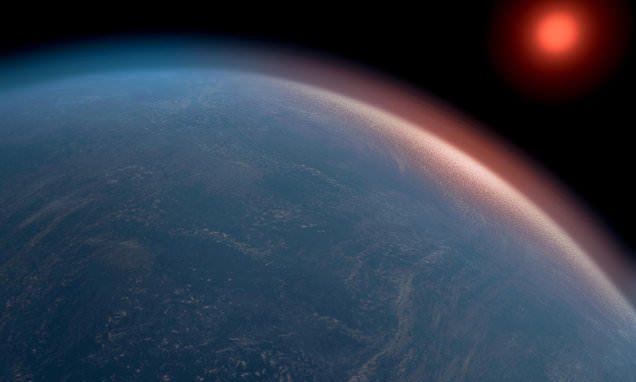WASHINGTON, April 16 (Reuters) – In what may mark a turning point in the search for extraterrestrial life, scientists using the James Webb Space Telescope have observed the strongest indicators yet of life beyond our solar system. The key findings point to chemical fingerprints in the atmosphere of exoplanet K2-18 b that, on Earth, are exclusively produced by biological processes.
The two gases – dimethyl sulfide (DMS) and dimethyl disulfide (DMDS) – identified in the observations are known on Earth to originate from living organisms, primarily marine phytoplankton such as algae. These findings suggest the potential presence of microbial life, though researchers stress this does not equate to direct evidence of living organisms.
“These are the first hints of an alien world that is possibly inhabited,” said astrophysicist Nikku Madhusudhan of the University of Cambridge’s Institute of Astronomy, lead author of the study published in Astrophysical Journal Letters.
A Transformational Moment in Astrobiology
“This is a transformational moment in the search for life beyond the solar system, where we have demonstrated that it is possible to detect biosignatures in potentially habitable planets with current facilities. We have entered the era of observational astrobiology,” Madhusudhan stated.
The search for life in our own solar system is ongoing, with interest in Mars, Venus, and various icy moons. However, this discovery centers on K2-18 b, a planet 8.6 times the mass of Earth with a diameter about 2.6 times greater. It orbits within the “habitable zone” of a red dwarf star located 124 light-years away in the constellation Leo – a region where conditions may allow liquid water to exist.

A New Class of Exoplanet: The Hycean World
Scientists categorize K2-18 b as a “hycean world,” a type of exoplanet hypothesized to host a liquid water ocean beneath a hydrogen-rich atmosphere. According to the researchers, these planets may provide ideal conditions for microbial life.
“The only scenario that currently explains all the data obtained so far from JWST (James Webb Space Telescope), including the past and present observations, is one where K2-18 b is a hycean world teeming with life,” said Madhusudhan. “However, we need to be open and continue exploring other scenarios.”
If such hycean worlds exist, “we are talking about microbial life, possibly like what we see in the Earth’s oceans,” he added. These oceans may be warmer than Earth’s. Asked about multicellular or intelligent life, Madhusudhan noted, “We won’t be able to answer this question at this stage. The baseline assumption is of simple microbial life.”
Chemical Clues: DMS and DMDS Detected
Both DMS and DMDS have long been predicted as significant biosignatures for exoplanets. Webb’s instruments detected one or both gases in the atmosphere of K2-18 b at a 99.7% confidence level, meaning there is still a 0.3% chance that the signal could be a statistical fluke.
Atmospheric concentrations were found to exceed 10 parts per million by volume. “For reference, this is thousands of times higher than their concentrations in the Earth’s atmosphere, and cannot be explained without biological activity based on existing knowledge,” Madhusudhan said.
Scientific Community Urges Caution
Other experts outside the research team emphasized the need for skepticism and further validation.
“The rich data from K2-18 b make it a tantalizing world,” said Christopher Glein, principal scientist at the Space Science Division of the Southwest Research Institute in Texas. “These latest data are a valuable contribution to our understanding. Yet, we must be very careful to test the data as thoroughly as possible. I look forward to seeing additional, independent work on the data analysis starting as soon as next week.”
Observing via the Transit Method
K2-18 b is part of the “sub-Neptune” category of exoplanets — larger than Earth but smaller than Neptune. The chemical composition of its atmosphere was assessed using the transit method, which involves observing the starlight that passes through a planet’s atmosphere as it crosses in front of its host star.
Webb detected a slight dimming of the star’s light and captured spectral data that revealed the gases present. Previous Webb observations had already identified methane and carbon dioxide in the planet’s atmosphere, marking the first detection of carbon-based molecules in a planet’s habitable zone.
What’s Next for the Search?
The discovery marks a significant step, but Madhusudhan underscored the need for restraint.
“First we need to repeat the observations two to three times to make sure the signal we are seeing is robust and to increase the detection significance” to a level where the odds of a statistical error fall below one in a million, he said.
“Second, we need more theoretical and experimental studies to make sure whether or not there is another abiotic mechanism (one not involving biological processes) to make DMS or DMDS in a planetary atmosphere like that of K2-18 b. Even though previous studies have suggested them (as) robust biosignatures even for K2-18 b, we need to remain open and pursue other possibilities,” Madhusudhan explained.
The long-standing human question — “Are we alone?” — may finally be on the cusp of an answer. But for now, it remains a question approached with both excitement and scientific caution.
“It is in no one’s interest to claim prematurely that we have detected life,” Madhusudhan said.




